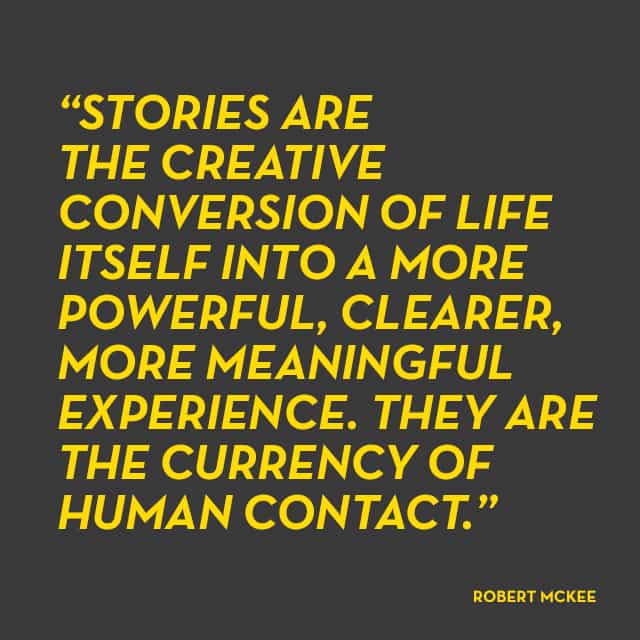Loving The Why: How Storytelling Inspires Product Development
In developed countries today, digital marketing experts estimate that most individuals are exposed to between 4,000 and 10,000 advertisements each year and as many as 55,000 brands. We live in an age of information overkill with intensely trained consumers adept at reading brand messages and cutting through the noise to find the truly authentic and reject the illusory. Brand building has become trickier and ever more complicated. The traditional broadcast-based model of branding has passed. Consumers are now active participants in value creation, both discerning and empowered; they drive today’s economy forward—not enterprises.
Consumers vote on your brand every day, with your competitors waiting in the wings—just one click away. It’s never been easier to leapfrog an incumbent through fulfilling an unmet market need or desire as it is today, especially when the first interaction a consumer has with your brand is typically a digital one. Consumers now have the power to insist on better experiences, and if you don’t deliver them—someone else will. You have to know them and know them deeply. Create products that fulfill their desires deliver on their beliefs and anticipate their needs.
GET PAST ‘THE WHAT’ TO BE SUCCESSFUL
The biggest thing we see when companies are developing a product, service or building a brand, however, is that they get stuck on the “what” of the thing. What the product does? What the company does? This thing. And this thing. And this. And that’s great, but the bigger question is why? Savvy consumers look past what a product does; they want to know what makes it authentic? What’s the backstory? Why should they believe in you? People are not just buying products; they are buying better versions of themselves and they want to know how it shapes their lives and their narrative.
Consumers don’t want to be sold; don’t talk at them hawking your brand message, they want something more in addition to the sales pitch. They want you to reach them on an emotional level. They want to know what’s in it for me? They want a story. Show them what your product or service will allow them to do, how it will enrich their lives.
The ‘Why’ is the most important storytelling variable in the brand development equation. Understanding, much less embracing, what a product does means very little without the why—without the story. Additionally, in the current commercial climate, consumers are increasingly trading up for experiences over things. And what is an experience if not the promise of a story, or at the very least, the opportunity to do something and have a story to share later?
PRODUCTS WITH STORY, STORY AS PRODUCT
The construct of “story” is a tale as old as time. It’s in our DNA to repeat and relive narrative. Stories are vital to existence, and they convey more than facts—they trade on emotional currency. They delight with their details. Entice with their persuasiveness. And importantly to companies creating products and brands, they connect us as we share around the fire, the table, or our social circles, real world and online.
It’s a cultural shift. A commercial shift. And something that more companies should have a better understanding of. So, when conducting product development exercises, we start with two evocative but simple questions. Think for a moment about your organization:
Is everyone on the same page?
Is everyone telling the same story?
Don’t fret if the answer is no; you might just need a little help crafting a cohesive narrative and solidifying your product message.
Here are the eight storytelling techniques THRIVE uses to enhance business storytelling that builds brands and create products that people love, advocate for, and pass their adoration of along to their friends:
1. START YOUR STORY CLOSE TO HOME
Stories that resonate start from within—inside the culture of your company. Ensuring everyone within the business knows, understands, and buys into your product story is vital to moving development in the right direction—cohesively and clearly toward customers. But it isn’t always easy.
Traditionally, manufacturing has focused on technology, looking to generate benefits to give to consumers, not because they were necessarily needed but because they were technologically possible. The underlying assumption being that consumers would automatically value a breakthrough in technological power in whatever shape or form it was presented to them in. Marketing was responsible for creating desire around the technology through stimulation, status and self-expression. Unfortunately, this thinking is problematic, and generally results in every part of the company that touches the product telling a different story: industrial design and engineering, design and marketing, administrative and the C-level. The result is discord, and a Frankenstein’s monster of sentiment shoved back together and stuffed in a pretty package.
What you should remember: Consider story first, and everyone starts—and ends—on the same page. All you have to do is stay on script.
2. EMBRACE THE NARRATIVE CONSTRUCT
Storytelling for business is a lot different than simply reciting a list of facts. Science proves it: Storytelling engages the brain in different ways than hearing simple facts. Namely, narrative activates parts of the brain that allow the listener to connect what they’re hearing or reading with their own experiences and feel emotionally charged by the information. The brain then releases dopamine, making the item easier to remember. For this reason, we like to think of narrative as a mental primer for people to receive new information. Great news for those product features and benefits you need to get across—wrapping them in a compelling story ostensibly helps retention.
The traditional constructs of narrative are also useful in other ways. Setting a contextual framework means people inherently understand certain aspects of your product based on the framework in which it’s presented. That amounts to less explanation on your part. Additionally, delight in the form of surprise or humor makes the journey memorable. The inherent peaks and valleys of good storytelling are also useful: a product might be solving a problem (which speaks to conflict) but the whole story can’t be a constant reminder of that, or you’ll force your audience into a state of emotional exhaustion. Good stories rise and fall. They create anticipation. And they never give up their ending before it’s time. They offer enough information to answer their audience’s questions and don’t leave people feeling confused or uninformed about the product. And some even invoke wonder and amazement ending with moments that “wow.”
Note that these constructs are mix-and-match: Not every product or service has to inspire “How did they do that!?” but you should recognize this as an important distinction for product rollouts that are truly revolutionary.
The takeaway: Your product can do the same thing as someone else’s, but you can sell more of it if your brand storytelling is better. Use the why to add value to the what.
3. STORYTELLING, AN EXERCISE IN TRUST
Business storytelling is a trust exercise between the teller and the audience. But trust is sometimes hard to come by. “Story” is the buzzword of the decade in marketing and branding, and to some, creating story sounds like a slimy opportunity to fabricate something solely for the benefit of sales. Don’t think of it that way. Embrace the art of storytelling as truth telling: not the fabrication of fiction or playing angles, but instead revealing or activating honesty. How?
Step 1: Make a promise with your product/service.
Step 2: Deliver on the promise of said product/service.
It’s that simple. Use facts to validate your position, and create a message that’s real enough that it resonates on a human level.
How do you know if you’re honest? Ask people. Get feedback from the real people who work inside your organization, who buy your products and know your brand. Humans are great at seeing through plot holes.
4. KNOW WHO YOU’RE TALKING TO, AND BE CLEAR AND SPECIFIC
A story that meanders isn’t an effective one. The storyteller must respect his or her audience’s time, only include the things that are truly important, and not linger or dwell on items that don’t matter. A great storyteller—whether in service of a brand, a presentation, or standing at a podium at a writers’ conference—works hard to direct their audience to look at just what they need at the right point. They reduce clutter with organized, specific narrative with a clear goal. At THRIVE, we ensure we do this by engaging in deep ethnographic research and immersive empathy as storytelling techniques which work to understand not just the what and why, but the who: audience.
The bottom line: Your audience will tell you everything you need to know. All you have to do is listen. Listening will bring understanding, and you can use that knowledge to create a product story with real resonance.
5. IF YOUR BUSINESS SHIFTS, SHIFT YOUR STORY
Things change—for businesses, in the marketplace, and in the public’s perception. Where companies go wrong is when they’ve taken the time and effort to invest in a story but then don’t let the story shift when insight, data, or the winds of market change force their overall trajectory to change. As long as your story shifts with your product or business’s flight-path, you’re ok. Better than ok—you’re responsive and nimble. Problems arise when organizations live in the past and decide, “We’ve invested so much time in this story, we just need to make it fit.”
A little dramatic metaphor: Imagine seeing the musical Les Misérables on the set for Rocky Horror, for no other reason than because “We’ve already invested so much in the set, so why not use it?” It would be absurd.
6. USE STORY AS A WAY TO COURSE-CORRECT
As we said before, things change, but the brilliant thing about story is it’s a low budget way to course-correct a brand. Story comes initially from imagination. It’s not a physical fabrication. If your product message drifts one way and your story goes another, story is much easier to re-evaluate and re-align than a product is to re-engineer.
Remember that narrative doesn’t have to be a straight line, either. Imagine in the course of promoting your newest product you discover something unexpected. A story that goes something like, ”We set off on this path to do this thing…and we failed. But in failing, we found this other amazing thing,” is honest, vulnerable, and connective. Who doesn’t make a mistake now and then? The value is in learning from it, and the marketing value is in owning that admission.
7. RECOGNIZE THAT NARRATIVE IS CARING
Storytelling is all about sharing something with an audience. And in the best examples, it’s more than a one-way conversation. Great storytelling allows your story to become your audience’s story—or “our story” together, which demonstrates empathy. A lot of companies like to message at you. While telling is absolutely part of the equation, listening is just as important and shows that you care what your audience thinks and wants.

Ignore internal conflict, commerce changes or sentiment shifts, and you are likely to find you’ve rolled out a product or service that no longer has a home. Then what? Listen—and create a new home for it by telling a different story.
8. ALWAYS LEAVE A LITTLE MYSTERY
Our final storytelling technique? Do like the great playwrights do, and never give it all away, even at the end. The best products and companies answer their audience’s questions and tell their story clearly, but leave a little mystery. If your audience feels like they know everything, you’ve closed the door on a relationship that keeps them coming back for more.
Apple is a great example of a company for which secrecy has its own story. The technology innovator seems like they have this overflowing well of talent and innovation somewhere, one they dip into only periodically. As soon as we’re thinking, “Well, they’ve thought of everything,” boom: they pop out with something new and delightful. Apple never exposes its entire innovation operation or shows us precisely how they work. That is mystery as an end to itself—a secondary value added to their products that comes from pure fascination.
The story is king. In our lives and the innovation process. Honor its power, follow the constructs passed down through time, and enjoy the process of creating, and you’ll be on the road toward building a powerful and unique narrative that’s all yours. Use it as the foundation for your business or your next great product.
“The golden age of advertising may be coming to a close, but the golden age of storytelling is just beginning.” So stop promising, stop bragging, and listen intently. Get to know people, not just markets. Be what people want. Create a new narrative together.
Get composing. Create a story worth telling.











